Vol 8 No 4 2023 – 46
Wurood Hantoosh Neamah 1*, Fatimah Ali Hasan 2, Wageeha Mosa Essaa 3
1University of Basrah, Basrah, Iraq;
2University of Basrah, Basrah, Iraq; fatimah.hasan@uobasrah.edu.iq;
3University of Basrah, Basrah, Iraq; wageeha.essaa@uobasrah.edu.iq;
* Correspondence: wurood.neamah@uobasrah.edu.iq; Tel.: (+9647819865272)
Available from. http://dx.doi.org/10.21931/RB/2023.08.04.51
ABSTRACT
Basrah is a southern Iraq governorate bordering Kuwait to the south and Iran to the east. It is the second population city in Iraq after Baghdad. Via the directed questionnaire to 22 herbalists, a list of medicinal herbs used in ascending order by the flock in a city was obtained. The five most used herbs on the list head are Matricaria chamomilla (chamomile), Nigella sativa (black seed), Anchusa italica (Italian bugloss), Pimpinella anisum (anise), and Trigonella foenum graecu (fenugreek). GC\MS analysis of the first five herbs displayed numerous remarkable constituents, including N-Hexadecanoic acid, Thymoquinone, 9,12-Octadecadienoic acid, 2,3-Dihydroxypropyl ester, 5- Hydroxymethylfurfural, Anethole, Vitamin E, Campesterol, Stigmasterol, and gamma.-Sitosterol that elucidate the purpose from a comprehensive utilization of these herbs by folk in the city. A current study adds a new input to the database. It exhibits an integrative investigation of Basrah governorate’s most used medicinal herbs, their constituents, and their therapeutic and pharmacological role.
Keywords: Basrah, Constituents, GC/MS, Herbs, Pharmacology role, Therapy role
INTRODUCTION
Iraq was previously well known for a significant variation of wild plants due to its geographic location and climatic circumstances. It has 363 medicinal plant species belonging to about 270 genera from approximately 98 families 1. Basrah is one of the three essential cities established in Iraq after Baghdad and Mosul. It is located in southern Iraq, bordering Kuwait to the south and Iran to the east 2. Basrah embraces Shatt Al Arab, a considerable river from the confluence of the great Euphrates and Tigris rivers at Qurna town. A river penetrates the city and connects it with the Arabian Gulf, which gives the town a coastal feel. Shatt Al Arab has numerous branches that feed huge lands in Basrah and give the city agricultural features 3. Water abundance, fertile soil, and warm temperature paved for diversity in wild plant growth, which was used by folk for medical purposes for centuries. However, in two recent decades, several causes have influenced the abundance and variety of wild plants, including climate change, salinity intrusion, drought, desertification, topography changes and human activities. Substantial desert areas in Basra were previously green and covered with different wild and implanted plants 4.
Furthermore, these changes caused the decline of agricultural lands and deterioration of soil fertility, significantly affecting previous causes in the density and distribution of wild plants. Consequently, they reduced the exhibition of local herbs in the markets. However, herbs markets in Basrah present a variety of species of herbs with numerous forms and have customers from various social classes. Due to the need for a database about medicinal herbs in Basra governorate, including the species of medicinal herbs, most used herbs, therapeutic purposes, and their constituents, a current study has been executed to provide suitable information for the incomplete database.
Furthermore, these changes caused the decline of agricultural lands and deterioration of soil fertility, significantly affecting previous causes in the density and distribution of wild plants. Consequently, they reduced the exhibition of local herbs in the markets. However, herbs markets in Basrah present a variety of species of herbs with numerous forms and have customers from various social classes. Due to the need for a database about medicinal herbs in Basra governorate, including the species of medicinal herbs, most used herbs, therapeutic purposes, and their constituents, a current study has been executed to provide suitable information for the incomplete database.
MATERIALS AND METHODS
Data collection
The study included a questionnaire for 22 herbalists in two primary markets: Al Ashar and Ancient Basrah (Basrah alqademh). The questionnaire included the following questions.
1- Age
2- Education level
3- Source of experience
4- Period of herbalist practice
5- License of herbalist practice
6- Most used herbs.
7- Therapeutic purpose of medicinal herbs
8- Source of medicinal herbs in the store
9- Herbalist background
10- Prescription of herbs
Herbs extraction
1 g of five selected herbs were weighted and soaked overnight with 10 ml of pure methanol, extracts filtered by filter paper (150 mm) and analyzed by GC/MS (Agilent 7890B GC, 5977A MSD, US).
RESULTS
The range of herbalists’ ages was between 27 and 70, and their education levels ranged between primary school and bachelor’s degrees, meaning all herbalists could read and write. Fourteen herbalists inherited the vocation from their granddads, and 8 acquired the skills through practice. The range of their occupation practice was between 2 and 60 years. Eight of them do not have a license for vocational practice, which leads to having a double responsibility from the legal side. During the questionnaire, we found that most sold herbs are imported from Iraq from different countries such as Iran, India, Turkey, and Syria. However, a few herbs, such as fenugreek, coriander, mint, and thyme, are cultivated in Iraq and shopped in the local markets. None of the herbalists in the questionnaire have any knowledge or background about the active constituents of herbs exhibited in their stores. Also, they do not have any background about specific constituents in the sold herbs because they needed to have the opportunity to get classes or academic education about medicinal and aromatic plants. When herbalists were asked the last question, they were concrete about giving customers a suitable dose and the correct therapeutic period of required herbs under the pretext that it is (the most required herbs are known and continually repeated by the customers). However, the alleged pretext may need to be revised to avoid the safety problems.
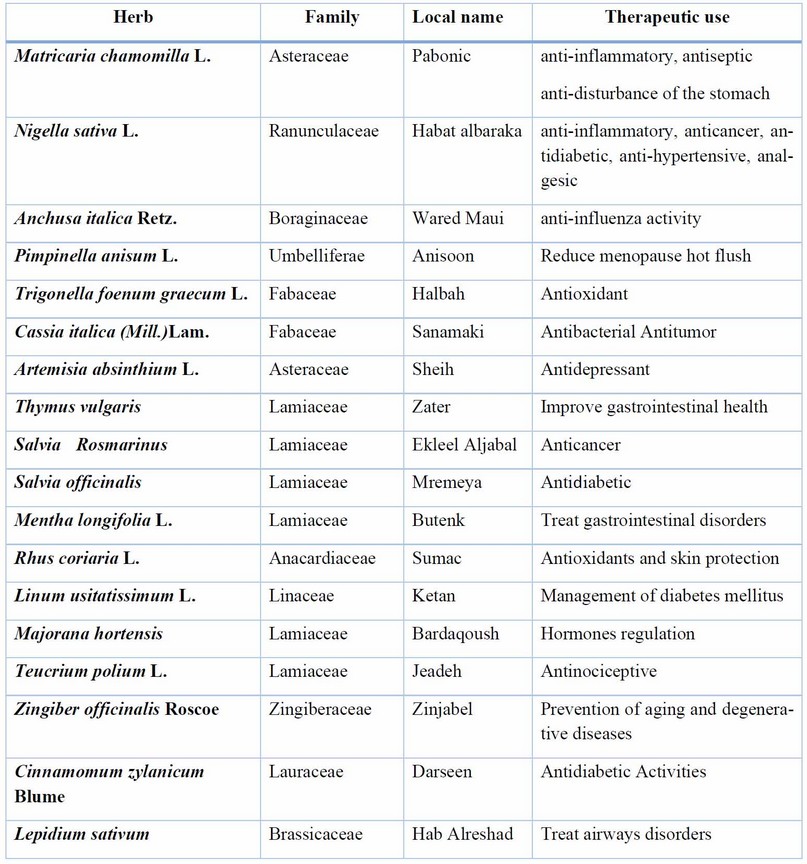
Table 1. Herbs are used widely by folk, and their therapeutics are according to herbalists.
GC/MS analysis
The first five herbs were selected from the list, and GC/MS analyzed their methanolic extracts to identify their active constituents.
Chamomile Matricaria chamomilla L.
Figure (1) and Table (2) illustrate the GCMS analysis of the essential constituents in the methanolic extract of Matricaria chamomilla flowers.

Table 2. GC/MS analysis of active constituents in Matricaria chamomilla flower extract.
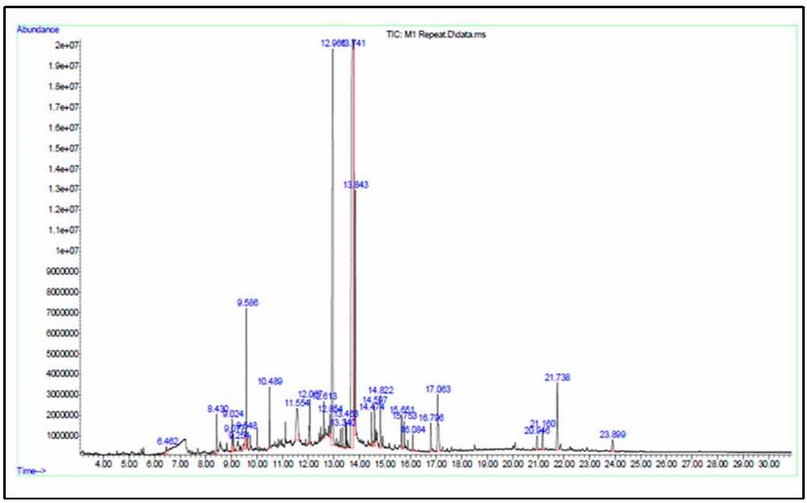
Figure 1. GC\MS analysis of methanolic extract of Matricaria chamomilla flowers.
Representative peak area of N-Hexadecanoic acid at RT 12.966, Eicosane at RT 15.651, Campesterol at RT 20.946, Stigmasterol at RT 21.16, and gamma. -Sitosterol at RT 21.738
Black seeds Nigella sativa L.
GC\MS analysis of the methanolic extract of Nigella sativa seeds shows the remarkable components in Figure (2) and Table (3)

Table 3. GC/MS analysis of active constituents in Nigella sativa seeds extract.

Figure 2. GC\MS analysis of methanolic extract of Nigella sativa seeds.
Representative peak area of Thymoquinone at retention time (RT) 9.329, Caffeine at RT 12.570, N-Hexadecanoic acid at RT 12.982, 9,12-Octadecadienoic acid at RT 13.741, 2,3-and hydroxypropyl ester at RT 17.117
Italian bugloss Anchusa italica Retz.
Figure (3) and Table (4) exhibit the GCMS analysis of the significant content of the methanolic extract of Anchusa italica flowers.

Table 4. GC/MS analysis of active constituents in Anchusa italica flower extract.
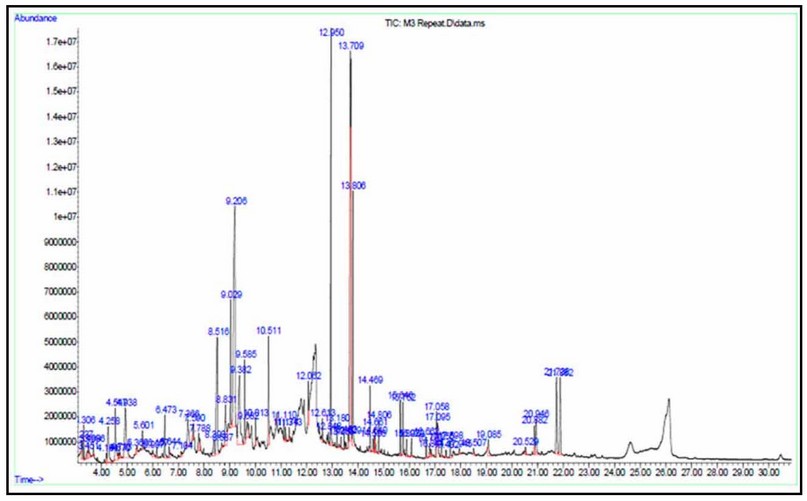
Figure 3. GC\MS analysis of a methanolic extract of Anchusa italica flowers
The representative peak area of 5-Hydroxymethylfurfural at retention time (RT) 9.206 and Campesterol at RT 20.946
Anise Pimpinella anisum L.
An essential active compound of methanolic extract of Pimpinella anisum seeds is illustrated in Figure (4) and Table (5) by GC/MS analysis.

Table 5. GC/MS analysis of active constituents in Pimpinella anisum seeds extract.
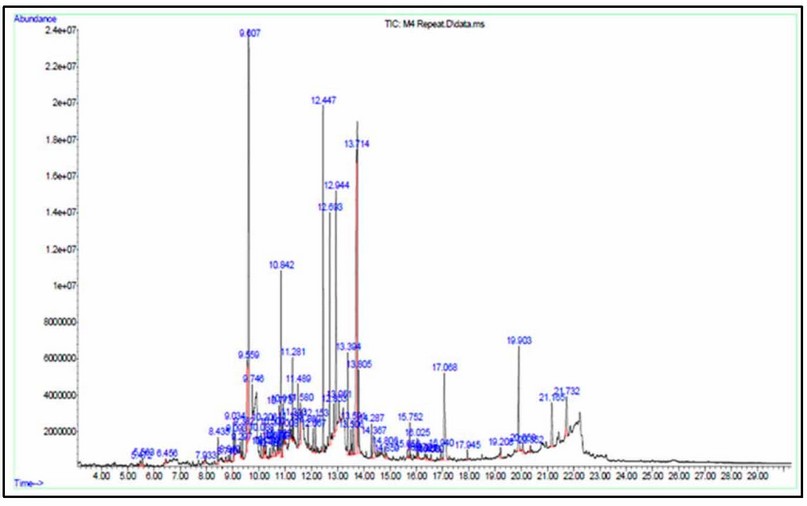
Figure 4. GC\MS analysis of methanolic extract of Pimpinella anisum seeds.
The representative peak area of Anethol at retention time (RT) is 9.607, and that of Stigmasterol is at RT 21.165.
Fenugreek Trigonella foenum graecum L.
The GCMS analysis of the remarkable components of the methanolic extract of Trigonella foenum graecum seeds obtained the result exhibited in Figure (5) and Table (6).

Table 6. GC/MS analysis of active constituents in Trigonella foenum graecum seeds extract
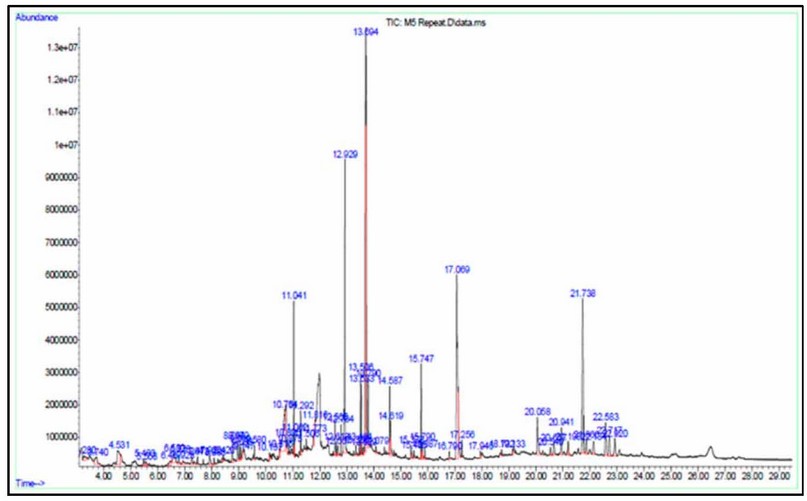
Figure 5. GC\MS analysis of methanolic extract of Trigonella foenum graecum seeds
Representative peak area of Vitamin E at retention time (RT) 20.058, gamma. -sitosterol at RT 21.738, and Campesterol at RT 20.941
DISCUSSION
Herbs markets in Basrah are busy markets with high economic value. However, it is not controlled by rules important in selling and using herbs. The rules in the herbs market, including importing, exporting, selling, buying, usage, storage, and exhibiting, and rules related to the herbalists, will organize the work in the scope and increase the significance of the herbs market. Table (1) shows herbs used widely by folk and their therapeutics according to herbalists.
Matricaria chamomilla or Pabonic (a common name in Iraq) was at the head of the list of herbs used mainly in Basrah, the plant belonging to the Asteraceae family. GC/MS analysis of a methanolic extract of chamomile flowers exhibited numerous important compounds (Figure 1). The most crucial compound with anti-inflammatory properties and a high peak area percentage (Area pct) is N-Hexadecanoic acid 20.457 (Table 2). Fatty acids. Such as conjugated linoleic acid and N-Hexadecanoic acid extend anti-inflammatory effects by decreasing the production of inflammatory mediators such as prostaglandin E2, IL-6, IL-1β, TNFα, and nitric oxide 5. Also, N-Hexadecanoic acid is reported as an inhibitor of the phospholipase A2 enzyme that hydrolyzes phospholipid membranes and releases fatty acids that initiate inflammation 6. GC/MS analysis shows 0.904 area pct of Eicosane (Table 2). Eicosane has anti-inflammatory, analgesic, antipyretic, and antiulcer properties against acetic acid-induced writhing, formalin-induced paw licking, carrageenan-induced paw edema, and brewer’s yeast-induced pyrexia in rats model 7.
Furthermore, Eicosane downregulated proinflammatory cytokines (TNF-α and IL-12) and acted as an anti-inflammatories in vitro assay 8. Campesterol, Stigmasterol, and gamma-sitosterol are Phytosterols (PSs) and plant-originated steroids, showing 0.610, 0.890, and 3.214 peak area percentages (Table 2). The structural resemblance of PSs with cholesterol enables them to displace low-density lipoprotein (LDL) cholesterol in the human intestine and consequently reduce the risks associated with heart problems 9.
Among various medicinal herbs, Nigella sativa L. or Habat albarakh (Ranunculaceae family) is the most important due to a rich historical background in pharmacological potential 10-14. In a current study, we obtained several active compounds from GC/MS analysis in the methanolic extract of Nigella sativa L seeds (Figure 2). N-Hexadecanoic acid, 9,12-Octadecadienoic acid, and 2,3-dihydroxypropyl ester recorded a high peak area percentage, 13.646, 31.216, and 17.124, respectively (Table 3), the combination of three constituents has antimicrobial, anti-inflammatory, antioxidant and hepatoprotective activity 15. Thymoquinone 2.988 area pct is the most effective bioactive constituent in Nigella sativa L 16. Thymoquinone’s Pharmacological properties range from antioxidant 17, cardioprotective 18, Antimicrobial 19, gastroprotective 20, neuroprotective 21., and anticancer properties 22. Caffeine 2.120 area pct (Table 3) is one of the constituents identified in the methanolic extract of Nigella sativa L. Caffeine is reported in pain management due to its structure that is similar to adenosine structure; therefore, Caffeine combined with A2a adenosine receptors causing inhibiting and blocking their action. Caffeine does not change dopamine release and does not have abuse possibility like other adenosine-blocking agents such as cocaine. Blocking of adenosine receptors may reduce pain sensation and give relief feels 23.
Anchusa italica Retz. The common name in the Basrah area is Wared Maui, The plant belongs to the Boraginaceae family and has polyphenol compounds with antimicrobial and antioxidant properties 24. GC-MS analysis of a methanolic extract of Anchusa italica Retz flowers showed a high area percentage of 13.654 of 5-Hydroxymethylfurfural (Table 4). This antioxidative has a cardioprotective effect mediated by inhibition of L-type Ca2+ channels in a mouse model 25. Anti-inflammatory properties of 5- Hydroxymethylfurfural support its potential therapeutic use for preventing and managing vascular diseases such as atherosclerosis through mechanisms involving the inhibition of VCAM-1 expression and NF-κB activation in vascular endothelial cells 26. 5- Hydroxymethylfurfural also produces modification of hemoglobin oxygen affinity with promising therapeutic potential to increase O2 delivery during hypoxic hypoxia due to improved cardiac indices, including stroke volume (SV), cardiac output (CO), ejection fraction (EF), and stroke work (SW) compared to the vehicle group at 5% O2 in rat model 27.
Pimpinella anisum L. is one of the herbs used widely in Basrah. It belongs to the Apiaceae family and has a common name, Aniston. The most important volatile oil in Pimpinella anisum L. that gives characteristic sweet, aromatic flavor and pharmacological properties to seeds is Anethol 28. Figure 4 shows the GC/MS result of the methanolic extract of Pimpinella anisum L. seeds; Anethol is recorded as the highest area prc. 19.6847 among anise constituents (Table 5). Anethole is a monoterpene with a position isomerism type and is the main constituent of essential oils from aromatic plants in the Apiaceae family, including anise, star anise, and fennel 29. Anethole is among numerous agents identified from fruits and vegetables that can interfere with several cell signaling pathways, including NFkB, AP-1, STAT3, Akt, Bcl-2, Bcl-XL, caspases, PARP, IKK, EGFR, HER2, JNK, MAPK, COX2, and 5-LOX that give basis to how Anethole not only prevent but also treat cancer and other diseases 30. Anethol is also one of the chemopreventive agents that suppress cancer cell proliferation, inhibit growth factor signaling pathways, induce apoptosis, inhibit angiogenesis, repress the expression of anti-apoptotic proteins, and inhibit cyclooxygenase-2 undergoing cancer treatment 31. Also, Anethole has an antinociceptive effect due to decreasing the production and release of inflammatory mediators 32. Stigmasterol is one of the anise constituents with an area percentage of 1.7646 (Figure 4). In one clinical study on CIA rats, Stigmasterol showed anti-inflammatory properties due to suppressing the expression of proinflammatory mediators (TNF-α, IL-6, IL-1β, iNOS and COX-2) and increasing the expression of anti-inflammatory cytokine (IL-10) through down-regulating the expression of NF-kBp65 with resulting in joint destruction reduction and histological alterations improvement 33. Furthermore, because of Stigmasterol’s antibacterial and antifungal properties, it is a candidate to serve as a lead compound in developing novel antimicrobial drugs 34.
Fenugreek herb, or Halbah, belongs to the Fabaceae family. It is widely used in cooking and traditional medicine by people in Basrah. From GC/MS analysis of a methanolic extract of Trigonella foenum graecum seeds, Figure 5 shows some important constituents, including gamma.-Sitosterol, Vitamin E, and Campesterol that have 8.5212, 2.1353, and 1.4115 area pct respectively (Table 6). Gamma-sitosterol reduced the glucose level in the blood of rats on all days of treatment, especially on day 6, compared to rats treated with alloxan-induced diabetes. In addition, gamma-sitosterol caused a significant reduction in the concentration of alkaline phosphatase (ALP) in the treated group compared to the diabetic control group. 35. Vitamin E family consists of alpha-, beta-, gamma-, delta tocopherols and tocotrienols. In the clinical study on heart failure patients, giving vitamin E 400 mg once a day orally for 4 weeks significantly reduced oxidative stress, including malondialdehyde and superoxide anion levels. It increased the antioxidant enzymes such as superoxide dismutase, catalase and glutathione reductase 36. Furthermore, the result of the study investigated the role of vitamin E supplements in the treatment or prevention of nonalcoholic fatty liver (NAFLD). It showed that vitamin E improves the abnormal profile of biochemical liver parameters with liver enzyme normalization, and histological assessment showed enhancement in lobular inflammation and hepatic steatosis following vitamin E treatment 37. Campesterol is a member of phytosterols, which are derived from steroid alcohols, are present in a variety of foods, and exhibit numerous physiological functions. In an in vitro model of human ovarian cancer cells, Campesterol exhibited effectiveness in cell death; calcium levels increased, ROS production was induced and suppression of cell proliferation, cell cycle progression, and cell aggregation 38.
Furthermore, Eicosane downregulated proinflammatory cytokines (TNF-α and IL-12) and acted as an anti-inflammatories in vitro assay 8. Campesterol, Stigmasterol, and gamma-sitosterol are Phytosterols (PSs) and plant-originated steroids, showing 0.610, 0.890, and 3.214 peak area percentages (Table 2). The structural resemblance of PSs with cholesterol enables them to displace low-density lipoprotein (LDL) cholesterol in the human intestine and consequently reduce the risks associated with heart problems 9.
Among various medicinal herbs, Nigella sativa L. or Habat albarakh (Ranunculaceae family) is the most important due to a rich historical background in pharmacological potential 10-14. In a current study, we obtained several active compounds from GC/MS analysis in the methanolic extract of Nigella sativa L seeds (Figure 2). N-Hexadecanoic acid, 9,12-Octadecadienoic acid, and 2,3-dihydroxypropyl ester recorded a high peak area percentage, 13.646, 31.216, and 17.124, respectively (Table 3), the combination of three constituents has antimicrobial, anti-inflammatory, antioxidant and hepatoprotective activity 15. Thymoquinone 2.988 area pct is the most effective bioactive constituent in Nigella sativa L 16. Thymoquinone’s Pharmacological properties range from antioxidant 17, cardioprotective 18, Antimicrobial 19, gastroprotective 20, neuroprotective 21., and anticancer properties 22. Caffeine 2.120 area pct (Table 3) is one of the constituents identified in the methanolic extract of Nigella sativa L. Caffeine is reported in pain management due to its structure that is similar to adenosine structure; therefore, Caffeine combined with A2a adenosine receptors causing inhibiting and blocking their action. Caffeine does not change dopamine release and does not have abuse possibility like other adenosine-blocking agents such as cocaine. Blocking of adenosine receptors may reduce pain sensation and give relief feels 23.
Anchusa italica Retz. The common name in the Basrah area is Wared Maui, The plant belongs to the Boraginaceae family and has polyphenol compounds with antimicrobial and antioxidant properties 24. GC-MS analysis of a methanolic extract of Anchusa italica Retz flowers showed a high area percentage of 13.654 of 5-Hydroxymethylfurfural (Table 4). This antioxidative has a cardioprotective effect mediated by inhibition of L-type Ca2+ channels in a mouse model 25. Anti-inflammatory properties of 5- Hydroxymethylfurfural support its potential therapeutic use for preventing and managing vascular diseases such as atherosclerosis through mechanisms involving the inhibition of VCAM-1 expression and NF-κB activation in vascular endothelial cells 26. 5- Hydroxymethylfurfural also produces modification of hemoglobin oxygen affinity with promising therapeutic potential to increase O2 delivery during hypoxic hypoxia due to improved cardiac indices, including stroke volume (SV), cardiac output (CO), ejection fraction (EF), and stroke work (SW) compared to the vehicle group at 5% O2 in rat model 27.
Pimpinella anisum L. is one of the herbs used widely in Basrah. It belongs to the Apiaceae family and has a common name, Aniston. The most important volatile oil in Pimpinella anisum L. that gives characteristic sweet, aromatic flavor and pharmacological properties to seeds is Anethol 28. Figure 4 shows the GC/MS result of the methanolic extract of Pimpinella anisum L. seeds; Anethol is recorded as the highest area prc. 19.6847 among anise constituents (Table 5). Anethole is a monoterpene with a position isomerism type and is the main constituent of essential oils from aromatic plants in the Apiaceae family, including anise, star anise, and fennel 29. Anethole is among numerous agents identified from fruits and vegetables that can interfere with several cell signaling pathways, including NFkB, AP-1, STAT3, Akt, Bcl-2, Bcl-XL, caspases, PARP, IKK, EGFR, HER2, JNK, MAPK, COX2, and 5-LOX that give basis to how Anethole not only prevent but also treat cancer and other diseases 30. Anethol is also one of the chemopreventive agents that suppress cancer cell proliferation, inhibit growth factor signaling pathways, induce apoptosis, inhibit angiogenesis, repress the expression of anti-apoptotic proteins, and inhibit cyclooxygenase-2 undergoing cancer treatment 31. Also, Anethole has an antinociceptive effect due to decreasing the production and release of inflammatory mediators 32. Stigmasterol is one of the anise constituents with an area percentage of 1.7646 (Figure 4). In one clinical study on CIA rats, Stigmasterol showed anti-inflammatory properties due to suppressing the expression of proinflammatory mediators (TNF-α, IL-6, IL-1β, iNOS and COX-2) and increasing the expression of anti-inflammatory cytokine (IL-10) through down-regulating the expression of NF-kBp65 with resulting in joint destruction reduction and histological alterations improvement 33. Furthermore, because of Stigmasterol’s antibacterial and antifungal properties, it is a candidate to serve as a lead compound in developing novel antimicrobial drugs 34.
Fenugreek herb, or Halbah, belongs to the Fabaceae family. It is widely used in cooking and traditional medicine by people in Basrah. From GC/MS analysis of a methanolic extract of Trigonella foenum graecum seeds, Figure 5 shows some important constituents, including gamma.-Sitosterol, Vitamin E, and Campesterol that have 8.5212, 2.1353, and 1.4115 area pct respectively (Table 6). Gamma-sitosterol reduced the glucose level in the blood of rats on all days of treatment, especially on day 6, compared to rats treated with alloxan-induced diabetes. In addition, gamma-sitosterol caused a significant reduction in the concentration of alkaline phosphatase (ALP) in the treated group compared to the diabetic control group. 35. Vitamin E family consists of alpha-, beta-, gamma-, delta tocopherols and tocotrienols. In the clinical study on heart failure patients, giving vitamin E 400 mg once a day orally for 4 weeks significantly reduced oxidative stress, including malondialdehyde and superoxide anion levels. It increased the antioxidant enzymes such as superoxide dismutase, catalase and glutathione reductase 36. Furthermore, the result of the study investigated the role of vitamin E supplements in the treatment or prevention of nonalcoholic fatty liver (NAFLD). It showed that vitamin E improves the abnormal profile of biochemical liver parameters with liver enzyme normalization, and histological assessment showed enhancement in lobular inflammation and hepatic steatosis following vitamin E treatment 37. Campesterol is a member of phytosterols, which are derived from steroid alcohols, are present in a variety of foods, and exhibit numerous physiological functions. In an in vitro model of human ovarian cancer cells, Campesterol exhibited effectiveness in cell death; calcium levels increased, ROS production was induced and suppression of cell proliferation, cell cycle progression, and cell aggregation 38.
CONCLUSIONS
The herbalist market in Basrah is rich with diverse herbs that are mostly imported from various countries and used by people in the city. GC\MS results for the most used herbs exhibited essential constituents such as N-Hexadecanoic acid, Thymoquinone, 9,12-Octadecadienoic acid, 2,3-Dihydroxypropyl ester, 5- Hydroxymethylfurfural, Anethole, Vitamin E, Campesterol, Stigmasterol, and gamma.-Sitosterol that illustrate a hidden reason behind the wide use of selected herbs in Basrah governorate
Author Contributions: Conceptualization, W.H.N., F.A.H, and W.M.E; methodology, W.H.N.; F.A.H and W.M.E formal analysis, W.H.N. writing and updating of original draft. All authors have read and agreed to the published version of the manuscript.
Funding: This research received no external funding.
Data Availability Statement: Data Availability Statements in the “Bionatura Research Data Policies” section at https://www.revistabionatura.com/policies.html.
Acknowledgments: The authors would like to thank all the herbalists for their collaboration.
Conflicts of Interest: The authors declare no conflict of interest.
REFERENCES
1. Ghazanfar SA. Handbook of Arabian medicinal plants. Boca Raton: CRC Press; 1994. 265 p. p.
2. Abdulzahra Al Rubaie D, Kasib Mizel A, Jarallah Sadoon A. The Geographic Location of Basra Governorate and its Effect on Iraq Power. مجلة ابحاث البصرة للعلوم الأنسانیة. 2018;43(3):200-21.
3. Hamdan A, Dawood A, Naeem D, editors. Assessment study of water quality index (WQI) for Shatt Al-arab River and its branches, Iraq. MATEC Web of Conferences; 2018: EDP Sciences.
4. Zwain FA, Al-Samarrai TT, Al-Saady YI. A Study of Desertification Using Remote Sensing Techniques in Basra Governorate, South Iraq. Iraqi Journal of Science. 2021:912-26.
5. Yu Y, Correll P, Heuvel JV. Conjugated linoleic acid decreases production of proinflammatory products in macrophages: evidence for a PPARγ-dependent mechanism. Biochimica et Biophysica Acta (BBA)-Molecular and Cell Biology of Lipids. 2002;1581(3):89-99.
6. Aparna V, Dileep KV, Mandal PK, Karthe P, Sadasivan C, Haridas M. Anti-inflammatory property of n-hexadecanoic acid: structural evidence and kinetic assessment. Chemical biology & drug design. 2012;80(3):434-9.
7. Okechukwu PN. Evaluation of anti-inflammatory, analgesic, antipyretic effect of eicosane, pentadecane, octacosane, and heneicosane. Asian Journal of Pharmaceutical and Clinical Research. 2020;13(4):29-35.
8. Chuah X, Okechukwu P, Amini F, Teo S. Eicosane, pentadecane and palmitic acid: The effects in <i>in vitro</i> wound healing studies. Asian Pacific Journal of Tropical Biomedicine. 2018;8(10):490-9.
9. Choudhary SP, Tran LS. Phytosterols: perspectives in human nutrition and clinical therapy. Current medicinal chemistry. 2011;18(29):4557-67.
10. Morsi NM. Antimicrobial effect of crude extracts of Nigella sativa on multiple antibiotic-resistant bacteria. Acta microbiologica Polonica. 2000;49(1):63-74.
11. Bamosa AO, Kaatabi H, Lebdaa FM, Elq AM, Al-Sultanb A. Effect of Nigella sativa seeds on the glycemic control of patients with type 2 diabetes mellitus. Indian journal of physiology and pharmacology. 2010;54(4):344-54.
12. Ng WK, Yazan LS, Ismail M. Thymoquinone from Nigella sativa was more potent than cisplatin in eliminating SiHa cells via apoptosis with down-regulation of Bcl-2 protein. Toxicology in vitro: an international journal published in association with BIBRA. 2011;25(7):1392-8.
13. Peng L, Liu A, Shen Y, Xu HZ, Yang SZ, Ying XZ, et al. Antitumor and anti-angiogenesis effects of Thymoquinone on osteosarcoma through the NF-κB pathway. Oncology reports. 2013;29(2):571-8.
14. Perveen T, Abdullah A, Haider S, Sonia B, Munawar AS, Haleem D. Long-term administration of N. sativa affects nociceotion and improves learning and memory in rats. Pak J Biochem Mol Biol. 2008;41:141-3.
15. Kumar PP, Kumaravel S, Lalitha C. Screening of antioxidant activity, total phenolics and GC-MS study of Vitex negundo. African Journal of Biochemistry Research. 2010;4(7):191-5.
16. Banerjee S, Padhye S, Azmi A, Wang Z, Philip PA, Kucuk O, et al. Review on molecular and therapeutic potential of Thymoquinone in cancer. Nutr Cancer. 2010;62(7):938-46.
17. Badary OA, Taha RA, Gamal el-Din AM, Abdel-Wahab MH. Thymoquinone is a potent superoxide anion scavenger. Drug and chemical toxicology. 2003;26(2):87-98.
18. Ojha S, Azimullah S, Mohanraj R, Sharma C, Yasin J, Arya DS, et al. Thymoquinone protects against myocardial ischemic injury by mitigating oxidative stress and inflammation. Evidence-Based Complementary and Alternative Medicine. 2015;2015.
19. Harzallah HJ, Kouidhi B, Flamini G, Bakhrouf A, Mahjoub T. Chemical composition, antimicrobial potential against cariogenic bacteria and cytotoxic activity of Tunisian Nigella sativa essential oil and Thymoquinone. Food chemistry. 2011;129(4):1469-74.
20. Arslan SO, Gelir E, Armutcu F, Coskun O, Gurel A, Sayan H, et al. The protective effect of Thymoquinone on ethanol-induced acute gastric damage in the rat. Nutrition Research. 2005;25(7):673-80.
21. Otaegui-Arrazola A, Amiano P, Elbusto A, Urdaneta E, Martínez-Lage P. Diet, cognition, and Alzheimer’s disease: food for thought. European journal of nutrition. 2014;53(1):1-23.
22. Almajali B, Al-Jamal HAN, Taib WRW, Ismail I, Johan MF, Doolaanea AA, et al. Thymoquinone, as a Novel Therapeutic Candidate of Cancers. Pharmaceuticals. 2021;14(4):369.
23. Sollevi A. Adenosine for pain control. Acta Anaesthesiologica Scandinavica. 1997;41(S110):135-6.
24. Khomsi ME, Imtara H, Kara M, Hmamou A, Assouguem A, Bourkhiss B, et al. Antimicrobial and Antioxidant Properties of Total Polyphenols of Anchusa italica Retz. Molecules. 2022;27(2):416.
25. Wölkart G, Schrammel A, Koyani C, Scherübel S, Zorn‐Pauly K, Malle E, et al. Cardioprotective effects of 5‐hydroxymethylfurfural mediated by inhibition of L‐type Ca2+ currents. British Journal of Pharmacology. 2017;174(20):3640-53.
26. Kim HK, Choi YW, Lee EN, Park JK, Kim SG, Park DJ, et al. 5‐Hydroxymethylfurfural from black garlic extract prevents TNFα‐induced monocytic cell adhesion to HUVECs by suppression of vascular cell adhesion molecule‐1 expression, reactive oxygen species generation and NF‐κB activation. Phytotherapy Research. 2011;25(7):965-74.
27. Othman Ghazi Najeeb Alani , Yassen Taha Abdul-Rahaman and Thafer Thabit Mohammed. Effect Of Vêo® Premium and Vitamin C Supplementation on Lipid Profile Before and During Pregnancy in Some Local Iraqi Ewes During Heat Stress. Iraqi Journal of Science.2021, Vol. 62, No. 7, pp: 2122-2130.
28. Sun W, Shahrajabian MH, Cheng Q. Anise (Pimpinella anisum L.), a dominant spice and traditional medicinal herb for both food and medicinal purposes. Cogent Biology. 2019;5(1):1673688.
29. Khudai M Y, Abdulateef S M, Mouhammed T Th, Alamili H S. Use of modern geometric design of fish ponds to increase welfare and blood parameters. Revis Bionatura 2023;8 (2) 82. http://dx.doi.org/10.21931/RB/2023.08.02.82.
30. Aggarwal BB, Shishodia S. Molecular targets of dietary agents for prevention and therapy of cancer. Biochemical pharmacology. 2006;71(10):1397-421.
31. AL-Abedy, A. N., Kadhim, J. H., Abdalmoohsin, R. G., & Al-Taey, D. K. (2021). Genetic diversity of tomato yellow leaf curl virus isolates and the effect of the virus on the hormone content of tomato (Solanum lycopersicum) plants. Research on Crops, 22(2), 347-355.
32. T. Jebril, N., Boden, R., Braungardt, C. Remediation Technique For Cadmium Contaminated Groundwater: A Systematic Review. Anbar Journal Of Agricultural Sciences, 2023; 21(1): 1-18. doi: 10.32649/ajas.2023.178800.
33. Ahmad Khan M, Sarwar AHMG, Rahat R, Ahmed RS, Umar S. Stigmasterol protects rats from collagen induced arthritis by inhibiting proinflammatory cytokines. International Immunopharmacology. 2020;85:106642.
34. Hamad, H.M., Shabeeb, Z.A., Awad, M.M. Expressions of CD274 (PD-L1) and CD47 rReceptors on the sSurface of bBlast cCells in AML pPatients (2022) Iraqi Journal of Science, 63 (6), pp. 2373-2387.
35. Al-Zubaidy, N. .; Al-Mubarak, N. F. .; Ahmed, A. M. . The Effect Of Fertilization And Repeated Mowing On Some Vegetative Characteristics And Yield Of Panicum Mombasa Plant. JLSAR 2021, 2, 34–45.
36. Ghatak A, Brar MJS, Agarwal A, Goel N, Rastogi AK, Vaish AK, et al. Oxy free radical system in heart failure and therapeutic role of oral vitamin E. International Journal of Cardiology. 1996;57(2):119-27.
37. Perumpail BJ, Li AA, John N, Sallam S, Shah ND, Kwong W, et al. The Role of Vitamin E in the Treatment of NAFLD. Diseases. 2018;6(4):86.
38. Bae H, Park S, Yang C, Song G, Lim W. Disruption of Endoplasmic Reticulum and ROS Production in Human Ovarian Cancer by Campesterol. Antioxidants. 2021;10(3):379.
Received: 26 September 2023 / Accepted: 15 April 2023 / Published:15 December 2023
Citation: Neamah, W.; Hasan, F. Essaa. Active constituents and their therapeutic and pharmacological role in the most used herbs in Basrah. Revis Bionatura 2023;8 (4) 51. http://dx.doi.org/10.21931/RB/2023.08.04.51



















